Abstract
The use of information and communication technologies develops new communications, imposes certain qualification requirements for the subjects of relations. There is a need to improve the effectiveness of education, providing the education sector with qualified teaching personnel. Their professional level influences the quality of specialists training whose potential of competences begins to be laid at the secondary school level. The uneven distribution of the number of students due to demographic dips and upsurges creates a problem of the provision of schools with teaching personnel. In addition, the situation is affected by the negative impact of socioeconomic factors on the attractiveness of education as a sphere of employment. This leads to a significant outflow of personnel from the professional sphere, the aging of personnel, and the inevitable deformation of the age structure. The presented article is devoted to the problem of the validity of the forecast data showing the need for teachers in the field of general education in Russia. A review of the results and a comparative analysis of studies of domestic and foreign scientists on this topic have been conducted. An assessment has been made analyzing the need for teaching personnel in the sphere of general education in Russia for the long term (until 2035), taking into account the dynamics of the age structure. The methodology used is based on projected demographic indicators (the number of students, the ratio of the number of teachers to students, the age structure of teachers).
Keywords: Teaching personnelsizeage structureforecast
Introduction
The potential of future specialists is laid in many respects already in the field of general education. Federal educational standards (FSES GE) are based on a systematic activity approach that shifts the positions of students from the “listener” to the “doer” (Sukhodimtseva & Gevurkova, 2017). The national project “Education” currently being implemented is aimed at modernizing school education. To achieve these goals, the issues of providing the education sector with qualified teaching personnel are particularly relevant. At the same time, the field of education in Russia, as in many countries of the world, is currently confronted with problems of a demographic nature (wave-like distribution of students, large outflow of personnel from the professional sphere, aging teaching personnel) (Korneeva, 2017; Agranovich et al., 2016).
In the context of these goals and existing problems, the task of justifying the need for teachers for general education, clarifying the forecast data on their number, taking into account the age structure, natural movement indicators, and the influx of young professionals, becomes more urgent. Comparison of the results with international research data allows us to assess the domestic situation in the field of education in the context of global trends.
Problem Statement
The main quantitative parameters in the general education sphere, which characterize the number and composition of participants of relations, make it possible to assess the state and development trends of this field, as well as form the basis for making forecasts for its development. The broad assessment of the provision of general education schools with teaching personnel at the federal level is carried out in terms of the actual ratio of the number of students to teaching personnel in comparison with its planned value.
To assess the need for teaching personnel for the medium and long term, it is necessary to take into account such demographic characteristics as the projected number of students, the natural movement of the population by age groups. At that, the consideration of the age structure of teaching personnel, statistics on the training of young specialists in the system of higher and specialized secondary education, their employment in the specialty, statistics on employee turnover, the influx of young specialists into schools are of particular importance.
For a long time, education as a sphere of employment was unattractive for specialists due to its socioeconomic features. For this reason, the enrollment of students in educational institutions of pedagogical profile was reduced, and only 10–15% of graduates worked in the specialty (Morozov, 2016). In addition, there was a significant employee turnover in active age cohorts. The inevitable consequence of this was the aging of the teaching personnel, which is especially pronounced in rural schools.
In the modern educational space, the teacher's role is significantly transformed and demands an adequate level of knowledge of modern information and communication technologies, a high innovative potential, and striving for self-development. The spread of inclusive education also requires additional knowledge and ability to organize the learning process for children with special educational needs (Agranovich, Zajceva, & Ermachkova, 2014; Korneeva, 2017).
The problem of aging personnel is manifested in the incomplete correspondence between the potential of teachers and the requirements of modern approaches to learning, as well as in the loss of contact with students. The challenge is to maintain the optimal age structure of teachers. To meet it, we propose to justify need for teaching personnel by taking into account the factors that affect the supply and demand in the field of general education, as well as the forecast of the age structure of teachers.
Research Questions
– assess the demographic situation in the country in relation to general education;
– explore the problem of staffing and their age structure in foreign countries;
– develop a forecast for the general need for teachers in the general education system until 2035;
– develop a forecast for the age structure of teachers in the system of general education until 2035.
Purpose of the Study
is to determine the need for teaching personnel in the field of general education in the long-term prospect, taking into account the forecast for their age structure and significant factors of influence.
Research Methods
The presented research was based on the official statistics of Russia and the OECD, the provisions of the regulatory and legislative documents in the field of strategic regulation of education. Methods used: statistical analysis, comparison, generalization, interpretation, forecasting, graphical presentation of data.
Findings
The general situation with personnel
According to Eurostat's forecast, by 2040, 45.5% of the population of the EU-27 will be over 65 years of age and the problem of a shortage of highly educated labor force will become acute. This will affect all industries, including education. In addition, it is noted that the current system of European higher education has moved away from the requirements of the labor market. This led to mass unemployment of young professionals who were not in demand, and also simultaneously to a growing shortage of personnel in the main areas (Vera, 2013). Similar processes occur in countries in other regions (Kao, Kao, Ding, Wang, & Liou, 2018).
The impact of various demographic and socioeconomic factors on education creates the problem of instability in staffing. Thus, a study of the provision of personnel for all Israel primary and secondary schools revealed a large turnover of teachers, and against the background of a general quantitative deficit, a more acute problem of the hidden deficit of subject teachers in individual disciplines was revealed (Donitsa-Schmidt & Zuzovsky, 2016).
The problem of unbalanced development of compulsory education in primary schools exists in China. Due to the ineffective regulation of the spatial organization of educational resources, there is a shortage of teachers in hard-to-reach settlements (about 70% of villages in mountainous areas) (Wang, Meng, & Ren, 2014). This kind of problems are also relevant in small Asian countries (Kao et al., 2018).
The situation in Britain, which has taken a significant influx of migrants, has its own characteristics. There already exists a problem of a shortage of secondary school teachers. On the rise of the wave of demographic changes in the number of students, the number of teachers' vacancies is increasing and at the same time there is a large outflow of personnel from the industry. The reason is seen in the ineffectiveness of the state policy, including deficiencies in the school financing system, the official increase in the age of graduation and vocational training completion, the increase in the number of small schools (See & Gorard, 2019).
Since the mid-1980s, the number of graduates in the pedagogical profile has been increasing steadily in the United States, but only about half of them are employed in public schools. At the same time, there is a shortage of teachers in certain subjects (for example, STEM and special education) and for certain types of schools (for example, remedial) (Cowan, Goldhaber, Hayes, & Theobald, 2016).
One of the main causes of employee turnover and instability in secondary schools is teachers' dissatisfaction with the work, that includes communication, involvement, leadership, school climate, personal development, professional growth, interest, and challenge (Crisci, Sepe, & Malafronte, 2018; Jeon & Wells, 2018). In developing countries (for example, in India) dissatisfaction with the education system and the desire for a higher standard of living leads to the migration of school teachers to developed countries. As a result, there is a serious shortage of teachers, more often in rural areas (Sharma, 2013). Especially, the problem of the young professionals’ turnover is highlighted. According to the Australian Council for Educational Research, about 30–50% of Australian teachers leave teaching in the first five years (Weldon, 2018).
Labor market conditions have a great influence on the choice of a teacher's profession. Thus, in a study of labor market conditions in education in Germany over three decades (1980–2009), it was found that, despite the high level of wages and the provision of high-quality training, there was a decrease in the students' admission to pedagogical specialties during periods of unemployment. The situation changed as soon as employment prospects became favorable (Neugebauer, 2015).
For Russia, the problem of the shortage of teachers in secondary schools is also topical, despite the tendency for their number to grow in recent years. The proportion of teachers in the total number of employees of educational institutions has stabilized (about 50%), while simultaneously the share of other teaching personnel has increased (speech therapists, educational psychologists, social pedagogues, etc.). At the same time, the long-term trend of increasing the teaching load continues. The amount of the workload of one teacher in urban schools is on average 9.4% higher than in rural ones: 1.3 and 1.2 workload per teacher, respectively (Agranovich et al., 2016). The 2016 survey showed that there are 2.3 times more unfilled teaching vacancies in urban schools than in rural schools (about 33 thousand units and 14 thousand units, respectively). In relative terms, this is 3.8% (urban schools) and 2.8% (rural schools) of the total number of vacancies (Agranovich et al., 2016). The current increase in the number of students and the immediate prospects for an increase in the number of secondary school students in accordance with the average scenario of the demographic forecast leads to the need to increase the number of teachers and other school workers (Gorbovsky & Mercalova, 2018).
The present situation of a shortage of teachers is largely connected with a considerable employee turnover. Thus, a study of the reasons for the outflow of teachers from school showed that stress factors such as problems with students, low wages, and too high workload exert the greatest influence on readiness to leave the profession. At the same time, confidence in their effectiveness and commitment to the profession can reduce the severity of the problem and contribute to the retention of personnel (Maslinsky & Ivanyushina, 2016). Young teachers have an acute problem of adaptation to the professional environment. The emergence of difficult and stressful situations cause a state of tension and doubts about professional competence, personal qualities (Andruschenko et al., 2017).
Pupil teacher ratio
An important indicator characterizing the workload of teachers, used to justify the need for them in the future and to assess the effectiveness of the school system, is the pupil teacher ratio (PTR). The analysis shows the differentiation of countries by this parameter (Figure
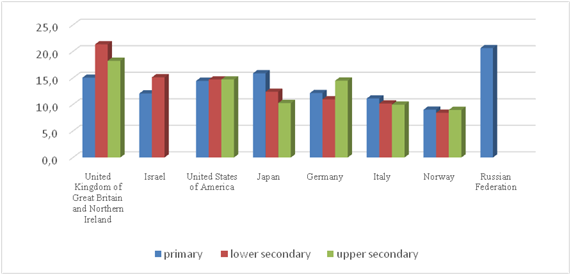
On average, this ratio is 11–12 people in a number of OECD countries. The smallest number of pupils per teacher is in Norway at all levels of secondary school: in primary and secondary schools — 9.0 people, in junior secondary schools — 8.4 people. In elementary school, the maximum number of pupils (15.9) per teacher is in Japan, and in junior and senior secondary schools — in the UK (21.3 and 18.2, respectively).
A study of the PTR indicator dynamics for Russian general education showed that in recent years there has been a significant increase in its values from 9 people in 2007 to 14 people in 2016 (Agranovich, Zajceva, & Ermachkova, 2014; Gorbovsky & Mercalova, 2018; Kao et al., 2018). In the following, a smoother increase in the value is observed — up to 14.9 people in 2018 (table
Moreover, the differences remain in the structure of the indicator itself. The analysis of the data in table
In the practice of making forecasts for the development of the general education sphere in Russia, another indicator is used - the pupil to member of teaching personnel ratio. The Teaching personnel category is more quantitatively representative, and in addition to teachers engaged in educational activities, it also includes employees engaged in mentoring students and organizing the educational process. The target value of this indicator for the future is set from its actual value in 2013 (11.6 people) with a gradual increase to 12.8 people. (2018). This value is used in the development of forecasts for the required number of teachers in the long term (2018–2035) (On the action plan (“roadmap”) “Changes in the social sphere, aimed at improving the effectiveness of education and science”: Order of the Government of the Russian Federation of April 30, 2014 № 722-p).
Age structure
An important aspect of the study of the state and development prospects of the general education sphere is the analysis of the teaching personnel (teachers) age structure. The example of OECD countries shows that the ratio of age cohorts of young teachers (under 30) to teachers aged over 50 is distributed over a fairly wide range (Figure
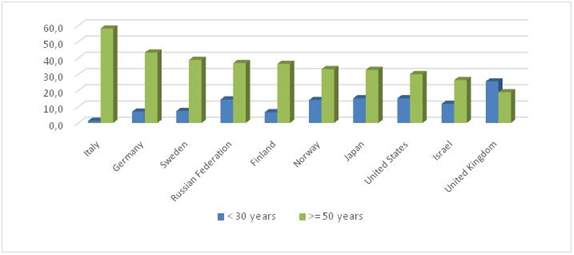
On the one hand, the number of teachers of pre-retirement and retirement age (over 50) in the OECD countries is growing, on the other, not only the number of young teachers in schools decreases, but also their influx. The maximum proportion of the older cohort of teachers is noted in Italy, the minimum – in the UK. Accordingly, the situation with young personnel is diametrically opposite there (Agranovich et al., 2016; The OECD Teaching and Learning International Survey (TALIS) – 2013 Results, 2013). The age structure of teachers varies significantly in terms of education levels (Fig. 03).
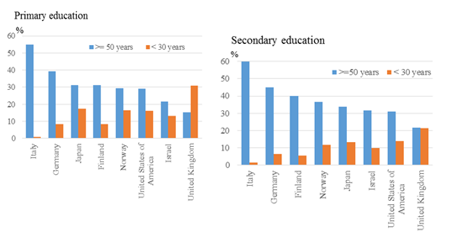
Italy shows the maximum proportion of teachers aged over 50 (higher than 58%) and the minimum proportion of teachers under 30 (only 1.5%). This ratio is true for both primary and secondary schools. The most balanced age structure of teachers is noted in the UK.
Russia does not stand out against other countries in the ratio of age cohorts of teachers. If the proportion of teachers aged 50 years and older is 35% on average in OECD countries, then in Russia its value is 36.8% (Fig. 2). At the same time, the share of young teachers is 14.4%, which is also similar to most countries and even higher compared to some of them. According to TALIS international study, the average age of Russian teachers was 52 in 2013 (The OECD Teaching and Learning International Survey (TALIS) – 2013 Results, 2013).
The proportion of teachers over 50 is gradually increasing. While in 2016 it was 36.8%, in 2018 it made up 38.3%. The share of young teachers has decreased, albeit slightly (by 0.2%), to 14.2%. It is interesting to note that in Finland, the leading country in the quality of education, the proportion of young teachers is about 7%, and of teachers over 50 is about 36% (Zair-Bek & Belikov, 2018).
Dynamics of the structure of the number of general education teachers in Russia by age groups in 2016–2018 is presented in Figure
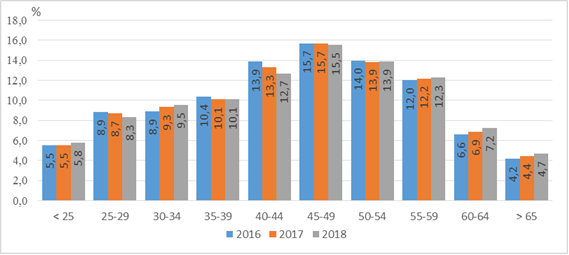
So, it is clear that the number of teachers over 50 years old in recent years has increased in the age ranges of 55–59, 60–64, 65 and more years, that is, the number of teaching personnel is growing, not even of pre-retirement, but already of retirement age.
The forecast for the number of teaching personnel in the general education system of the Russian Federation for the period until 2035 is presented in Figure
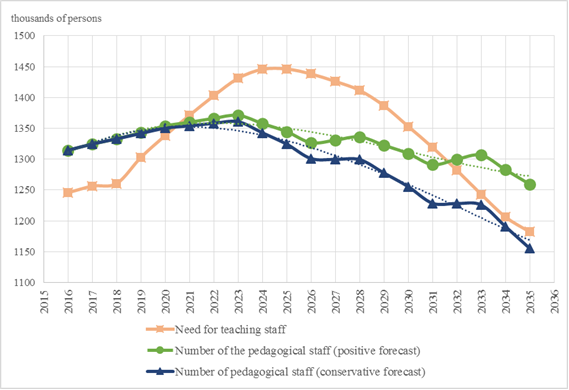
The need for teaching staff is calculated in accordance with the Rosstat demographic forecast by one-year age (age cohort 7–17 years) made until 2035 (Demographics: Data from the Federal State Statistics Service of Russia) taking into account the recommended ratio of the number of students to member of teaching personnel (On the action plan (“roadmap”) “Changes in the social sphere, aimed at improving the effectiveness of education and science”: Order of the Government of the Russian Federation of April 30, 2014 № 722-p) and the share of students in general education compared to cohorts of children aged 7-17 years old as of 2018.
Forecast variants are calculated based on the data of the statistical form No. OO-1 "Information about the organization providing training in educational programs of primary general, basic general, secondary general education" for 2016–2018 taking into account the estimated mortality rate of teachers by age groups. The optimistic version of the forecast is based on the assumption that the trend of growth in the number of young (up to 25 years) teaching personnel will continue for the forecast period. The conservative version of the forecast is based on the fact that the influx of young teachers is fixed at the level of 2018.
Currently, the shortage of teaching personnel is not acute, which is due to the large number of retired teachers working, but from 2021 the need for teaching personnel will start to grow at a rapid pace compared to the number of teaching personnel. Today, teaching personnel under the age of 25 makes up 5.8% of the total number of workers in the general education sphere. While maintaining the influx of young specialists at this level, by 2026 the shortage of teaching personnel in the general education system of the Russian Federation will be over 111 thousand people, and the shortage of teaching personnel will persist until 2032 in accordance with optimistic scenario conditions.
The number of working teachers of retirement age is increasing, although, at the moment, the most numerous cohort of teachers is in the age group of 45–49 years. If this trend continues, by 2025 every third teacher will be over 55 years old, and by 2030 - over 60 years old (Figure
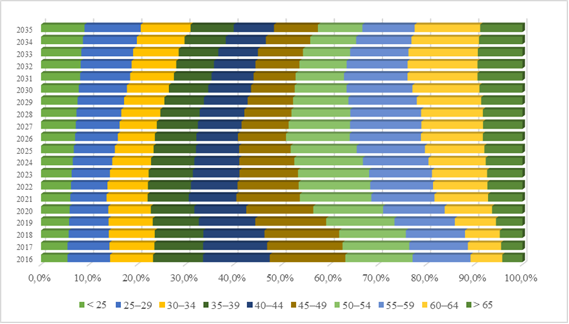
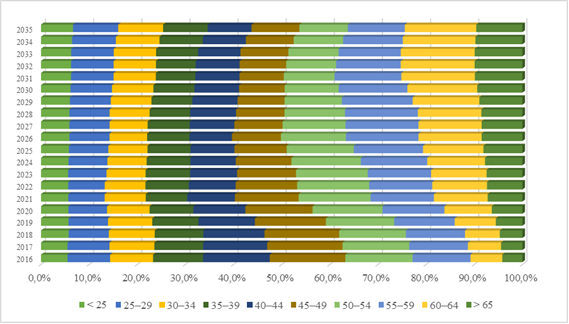
The problem of teaching personnel aging is of great concern. In modern education, skills in digital technologies applications are defined as the most important element of national curricula, and education throughout the world is largely changing with the help of modern technologies. Nevertheless, it is recognized that the digital culture of education and the training of teachers to work with modern technologies are still lagging behind the requirements (Langset, Jacobsen, & Haugsbakken, 2018). In the cohort of older teachers, the gap in the mentality of teachers and pupils increases, they find it more and more difficult to understand each other, there is a rejection, loss of interest in communication, etc. Therefore, it is necessary to develop measures aimed at supporting the sustainability of labor and resources in the industry, ensuring a balanced age structure of teaching staff (Sottimano, Guidetti, Converso, & Viotti, 2018).
Conclusion
Analyzing the state and development trends of the general education sphere in Russia and foreign countries, it has been established that demographic problems, instability in the education sector, and the aging of teaching personnel are characteristic of almost all countries. There is a large turnover of teachers, especially among young professionals. The main reasons for this are dissatisfaction with working conditions, the impact of stress factors, low wages, as well as excessive workload.
For Russia, the problem of the shortage of teachers in secondary schools is also topical, which is manifested in an increase in their workload. On average, the amount of workload of one teacher in the urban school is 1.3, in the rural school - 1.2. In addition, there is a hidden shortage of teachers (in terms of education levels, types of settlements, in interdisciplinary section). In accordance with the average scenario of a demographic forecast, in the medium term, it will be necessary to increase the number of teachers and other school workers. But despite the influx of young professionals remaining at the current level in the coming years (2021-2032), in the field of general education of the Russian Federation there will be a shortage of teaching personnel, which by 2026 will amount to more than 111 thousand people.
Forecasting the need for teaching employees (teachers) should take into account possible dynamics of the age structure. Preservation of the existing tendencies may result in a significant deformation of the age structure of teaching personnel and a further increase in the shortage of teachers. At present, the average age of a secondary school teacher in Russia is 45–49, by 2025 more than 35% of teaching personnel will be over 55 years old, and by 2030 - over 60 years old.
The results of the personnel analysis in the field of general education and the forecast data on the need for teaching personnel, taking into account the dynamics of age cohorts, can be used to maintain a balanced age structure of teaching personnel. To change the current situation, measures must be taken to improve organizational and methodological approaches, stimulate the influx of young personnel into the industry, increase the motivation of their activities, and provide social guarantees.
Acknowledgments
The study was made as part of the State Assignment of the Institute for Strategy of Education Development of the Russian Academy of Education, No. 073-00086-19-01 for 2019 and for the planning period of 2020 and 2021. The project "Producing a forecast of socioeconomic development pursuant to Resolution of the Government of the Russian Federation of November 14, 2015 No. 1234 "On the order of development, adjustment, monitoring, and control of the implementation of the forecast of socioeconomic development of the Russian Federation for the medium term" in accordance with the powers of the Ministry of Education of Russia."
References
- Agranovich, M.L., Adamchuk, D.V., Barinov, S.L., Belikov, A.A., Bolotov, V. A., Zair-Bek, S. I., … Zaytseva, O. V. (2016). Rossijskie uchitelya v svete issledovatel'skih dannyh [Russian Teachers in the light of Research Data]. Moscow: Publ. house of the Higher School of Economics [in Rus.].
- Agranovich, M.L., Zajceva, O.V., & Еrmachkova, Y.A. (2014). Rossijskoe obrazovanie v kontekste mezhdunarodnyh indikatorov. SHkol'nyj uchitel': obrazovanie, nagruzka, zarplata. Analiticheskij doklad. [Russian Education in the Context of International Indicators. School Teacher: Education, Workload, Salary. Analytical report]. Moscow: HSE Publ. House. Retrivied from: http://www.mamso.ru/node/73540 [in Rus.].
- Andrushchenko, T.Y., Arzhanyh, Е.V., Vinogradov, V.L., Minyurova S.A., Fedekin I.N., & Fyodorov A.A. (2017). Problemy professional'noj adaptacii molodyh pedagogov [Problems of Professional Adaptation of Young Teachers]. Psychological Science and Education, 9(2), 1–16. [in Rus.].
- Cowan, J., Goldhaber, D., Hayes, K., & Theobald, R. (2016). Missing Elements in the Discussion of Teacher Shortages. Educational Researcher, 45(8), 460–462.
- Crisci, A., Sepe, E., & Malafronte, P. (2018). What Influences Teachers’ Job Satisfaction and how to Improve, Develop and Reorganize the School Activities Associated with them. Quality and Quantity, 1 –17. Article in the press.
- Demographics: Data from the Federal State Statistics Service of Russia. Retrieved from: http://www.gks.ru/wps/wcm/connect/rosstat_main/rosstat/ru/statistics/population/demography/
- Donitsa-Schmidt, S., & Zuzovsky, R. (2016). Quantitative and Qualitative Teacher Shortage and the Turnover Phenomenon. International Journal of Educational Research, 77, 83–91.
- Gorbovsky, R.V., & Mercalova, T.A. (2018). Monitoring sistemy obrazovaniya: kontingent i kadry nachal'nogo, osnovnogo i srednego obshchego obrazovaniya [Monitoring the Education System: Contingent and Personnel of Primary, Basic and Secondary General Education]. Education Facts, 2(17), 32 [in Rus.].
- Jeon, L., & Wells, M.B. (2018). An Organizational-Level Analysis of Early Childhood Teachers’ Job Attitudes: Workplace Satisfaction Affects Early Head Start and Head Start Teacher Turnover. Child and Youth Care Forum, 47(4), 563–581.
- Kao, W.-H., Kao, K.-P., Ding, M.-H., Wang, P.-C., & Liou, B.-S. (2018). Analysis Modeling of College Students Sources. Lecture Notes in Electrical Engineering, 422, 519–528.
- Korneeva Е.A. (2017). Aktual'nye problemy sovremennosti: nekhvatka pedagogicheskih kadrov [Topical Problems of Our Time: Lack of Teaching Personnel]. Education and training, 1, 7–9. https://moluch.ru/th/4/archive/52/1945/ [in Rus].
- Langset, I.D., Jacobsen, D.Y., & Haugsbakken, H. (2018). Digital Professional Development: Towards a Collaborative Learning Approach for Taking Higher Education into the Digitalized Age. Nordic Journal of Digital Literacy, 13(1), 24–39.
- Maslinsky, K.A., & Ivanyushina, V.A. (2016). Ostat'sya uchitelem? Faktory, vliyayushchie na otnoshenie k uhodu iz uchitel'skoj professii [Staying as a Teacher? Factors Affecting Attitudes to Leaving the Teaching Profession]. Education Issues, 4, 8–30 [in Rus].
- Morozov, G.B. (2016). Pochemu vypuskniki pedagogicheskih vuzov ne rabotayut v obrazovatel'noj sfere? [Why do graduates of pedagogical universities do not work in the field of education?]. Contemporary Society and Government, 4(10), 64-68. Retrieved from: http://gmanagement.ru/index.php/ru/arxiv/4-2016r/534-morozov2-102016 [in Rus].
- Neugebauer, M. (2015). Who Chooses Teaching under Different Labor Market Conditions? Evidence from West Germany, 1980–2009. Teaching and Teacher Education, 45, 137–148.
- See, B.H., Gorard, S. (2019). Why don’t we have enough teachers? A Reconsideration of the Available Evidence. Research Papers in Education (in the press).
- Sharma, R. (2013). Teachers on the Move: International Migration of School Teachers From India. Journal of Studies in International Education, 17(3), 262–283.
- Sottimano, I., Guidetti, G., Converso, D., & Viotti, S. (2018). We Cannot Be "Forever Young", but our Children Are: A Multilevel Intervention to Sustain Nursery School Teachers' Resources and Well-being during their Long Work Life Cycle. PLoS ONE, 13(11), e0206627.
- The OECD Teaching and Learning International Survey (TALIS) – 2013 Results. (2013). Retrieved from: http://www.oecd.org/education/school/talis-2013-results.htm.
- Sukhodimtseva, A.P., & Gevurkova, Е.A. (2017). Obrazovatel'nyj process v kontekste obnovleniya metodov obucheniya [Educational Process in the Context of Updating Teaching Methods] In Modern education: Topical Issues of Innovation Achievement: transcript of VIII International Scientific and Practical Conference (pp. 252–256). Penza: Science and Education [in Rus].
- Vera, G. (2013). Ageing Europe. Young India Shortages and Supplies for the Labour Market? Öregedo európa, fogyó szakemberek – fiatal India, egyre több diplomas. Tarsadalomkutatas, 31(1), 40–54.
- Wang, Y.-H., Meng, H., & Ren, R.-H. (2014). MTFCAM based Spatial Accessibility to the Educational Resources from the Primary Schools in the Impoverished Mountain Areas. Energy Education Science and Technology Part A: Energy Science and Research, 32(6), 5859–5870.
- Weldon, P. (2018). Early Career Teacher Attrition in Australia: Evidence, Definition, Classification and Measurement. Australian Journal of Education, 62(1), 61–78.
- Zair-Bek, S.I., & Belikov, A.A. (2018). Ne tol'ko fakty: Pogovorim o vozraste [Not Just Facts: Let's Talk about Age]. Teacher's newspaper. Retrieved from: http://www.ug.ru/article/1061 [in Rus].
Copyright information

This work is licensed under a Creative Commons Attribution-NonCommercial-NoDerivatives 4.0 International License.
About this article
Publication Date
30 September 2019
Article Doi
eBook ISBN
978-1-80296-068-6
Publisher
Future Academy
Volume
69
Print ISBN (optional)
-
Edition Number
1st Edition
Pages
1-1054
Subjects
Education, educational equipment, educational technology, computer-aided learning (CAL), Study skills, learning skills, ICT
Cite this article as:
Lebedev*, K. V., Vasilieva, L. V., & Sumenova, E. S. (2019). Forecast For Pedagogical Workers Age Structure In General Education Of Russia. In S. K. Lo (Ed.), Education Environment for the Information Age, vol 69. European Proceedings of Social and Behavioural Sciences (pp. 522-533). Future Academy. https://doi.org/10.15405/epsbs.2019.09.02.60
